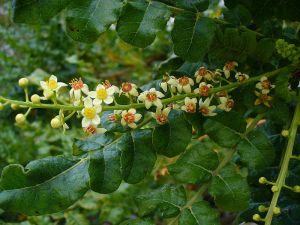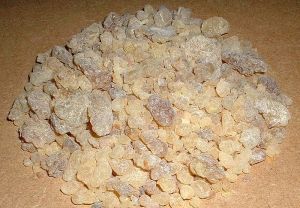
Spice shop in Dubai shows Frankincense, myrrh, nutmegs, cinnamon, chili flakes, dried lemons, smoked dried lemons, dried sage, chamomile, oregano, hibiscus and rose buds. Photo: Wikicommons
Frankincense and myrrh
These fascinating herbs are best known through the story of the Three Wise Men delivering gold, frankincense, and myrrh for the baby Jesus. Even though details of the story of the three wise men are questionable, the Bible does specify that gifts were given of gold, frankincense and myrrh. Besides gold, the value of which we can still understand, what was the value of these herbal gifts?
Frankincense and myrrh have long been known as ingredients in perfume and incense. Egyptians ground the charred resin into a powder called “kohl,” which they used to make the distinctive black eyeliner, melted into a depilatory and a paste to perfume the hands.
Where do they come from?
Both myrrh and frankincense grow as small trees or shrubs; they are of the botanical family Burseraceae. The Boswellia tree, Boswellia sacra, is the source of Frankincense. It is formed into a hardened resin produced by careful shaving of the bark of the tree.
Myrrh, Commiphora myrrha is a sturdy, spiny, shrub or small tree, usually with a distinct short trunk up to 4 m tall. Silvery outer bark, whitish or bluish grey, when peeled away from the greener under-bark, exude scented, translucent yellowish gum-resin in papery flakes.
They only grow in Middle East. The origins of myrrh and frankincense are traced to the Arabian Peninsula. According to Herodotus (5th century BC), “Arabia is the only country which produces frankincense, myrrh, cassia and cinnamon…the trees bearing the frankincense are guarded by winged serpents of small size and various colors.”
Don’t think they can be grown easily in California!
An internet search reveals that many experiments in growing Frankincense have been done, from botanists to bloggers, and none have survived but some at Cal State Biology Greenhouse in Fullerton, CA. There, a botanist has grown Boswellia carteri plants in clay pots with a medium of pure pumice. There is a source in Arizona that sells seeds, but the germination rate is only 2%!
What are they used for today?
Today, most of the internationally-traded myrrh and frankincense are still produced in the southern Arabian Peninsula. Studies have been done on their medicinal use today.
Frankincense, a natural antiseptic, sedative, and immune stimulant, was used as a treatment for respiratory problems, depression, infection, and tumors. Recent studies found particularly notable “trials related to asthma, rheumatoid arthritis, Crohn’s disease, osteoarthritis, and colitis”. Results of all trials indicated that B. serrata extracts were clinically effective.
Myrrh, Commiphora myrrha, has been recognized as an anti-inflammatory, astringent and wound-healing substance, as well as a treatment for gastric ulcers, and as an anti-tumor and anti-parasitic agent.
Frankincense is used in perfume, cosmetics, medicine and aromatherapy. Both are still used by herbalists for many health problems.
The gift of health
When the ‘Three Wise Men’ gave the Christ child frankincense and myrrh, they were doing much more than giving him something that smelled good. They were giving him a gift of good health.
Interested in more? Check out Snope’s view on the Three Wise Men here.
And All about Frankincense and Myrrh
Frankincense and Myrrh can be found at Amazon.
Has anyone seen this plant, Frankincense, in th U.S.? It would be interesting to know.




2 comments